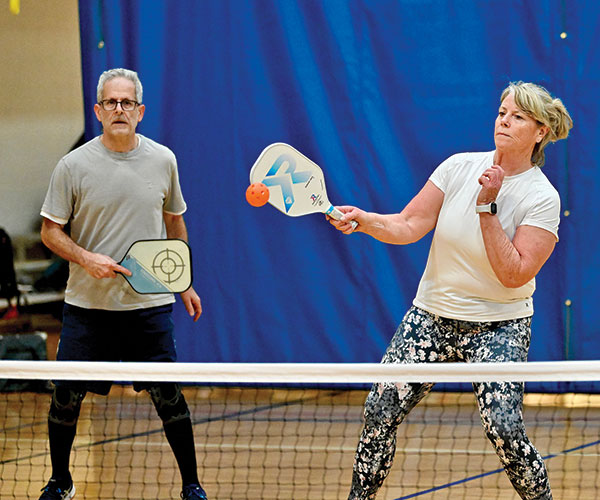Bob and Jean Arnold were holdouts. Both in their 90s and still in good health, the couple lived in the Cleveland Heights home where they had entertained friends for 58 years. They looked forward to regular visits from their children, grandchildren and great-grandchildren, who had moved away from the area.
"We enjoyed it very much," Bob says. "We were very happy there."
Still, it was rather large for just the two of them, he admits. And living on four floors (including the basement) was getting rather tiresome. So just last year, they began exploring their options for retirement living.
Their first thought was moving to the East Coast to be closer, geographically, to their extended family. Arnold's son even prescreened a number of Maryland retirement communities he thought they might enjoy. But when they considered the prospect of finding all new dentists, doctors, hairdressers and places to shop, they decided what they really wanted was a retirement community in the city they already called home.
Just about the time they started looking, an apartment opened up in Judson Park where Jean's sister had recently moved.
They loved the location, the ambiance of the neighborhood and the apartment layout offering ample independent living quarters, including a guest bedroom and space for a home office. Overlooking University Circle, the seventh-floor apartment in the 10-story high-rise had a great view.
"There's a lot of vegetation. You can see Terminal Tower, and on a very clear day, you can see the lake," Bob says.
Fearing that someone else would snatch up this special place, they shifted their moving plans into high gear, committed to the apartment in January and were moved in by April.
Their only regret? Not doing it sooner.
In hindsight, the logistics of the move were much easier than the Arnolds expected.
"And Judson helped tremendously," Bob says.
Making 'The Move of a Lifetime'
One of the biggest physical hurdles seniors face in transitioning to retirement living is dispersing the personal belongings they no longer need. Getting long-term homes fixed up and put on the market, as well as going through years of accumulated furnishings, personal papers and storage items, is a daunting task.
"It's a big deal," says Rob Lucarelli of Judson Services Inc., which operates three upscale retirement communities in University Circle and South Franklin Circle. Judson Park, where the Arnolds now live, is one of them.
It's why Judson is among a growing number of retirement homes that give new residents access to real estate agents and interior design consultants as part of their admissions package. Judson contracts a certain number of hours with independents. Additional time can be paid for by new residents as needed.
Susan Kent of Moving By Design has more than 15 years experience helping seniors decide what furnishings to take to their new downsized living quarters and figuring out what to do with the rest. She says it's a specialty that resides "where design and social work meet."
"It's exhausting, emotional work," she explains. "It involves decision making. Some people are matter of fact. Others have a harder time letting go. But it's rare that people view this as a liberating experience."
Kent typically works with clients in half-day or even two-to-four-hour blocks. She measures their furniture and creates floorplans to scale that help them envision how their belongings will fit into a new living space. After deciding what they will ultimately take to their new homes, she helps them disperse the rest. She puts dots on items spoken for by family members, then uses her connections with liquidators and antique dealers to help clients find buyers for whatever else is left behind.
She also works to find new homes for things like prized collections, quilts, linens or china that kids and grandkids — whom experience have shown are often mobile and "doing the Crate & Barrel thing" —don't want.
She sorts through old books, looking for limited editions or complete sets that might have value to book dealers in niche markets, then arranges for donations to the Case Western Reserve University or library book sales for the rest.
"This is a generation that doesn't want to waste things," she says. "They were like that long before it was politically correct."
Closer to a Wide Continuum of Care
Even among active seniors, there is a reluctance to make the move to retirement living for fear of losing their independence. With this in mind, many facilities now offer features such as fully equipped kitchens with full-size refrigerators, as well as washers and dryers in each suite (with the option of doing your own laundry or having it done).
"I always tell people they can be as independent as they want or get as much assistance as they need here," says Susan Lieberman of the Weils in Chagrin Falls. "We always say, •Move in to enjoy it, not when you need it.' "
About half of the first-time tours she gives are to adult children, nieces or nephews who often prescreen retirement communities for their elders, according to Amy Simon, admission and outreach coordinator there.
"Really, they can be more active here without all the responsibility they had before," Simon says, adding that many are surprised when they join their children on a tour and discover it has a resortlike atmosphere: happy hour three times a week, exercise classes, gorgeous patios, fine dining on-site and a real sense of freedom.
Lucarelli agrees. "There are financial benefits to making the decision to move in now — when they're hale and hearty," Lucarelli says.
Although the Arnolds moved into Judson as an independent living couple, they take comfort in the fact that assisted living and extended care are available to them down the road if either of them should need it.
Knowing that special services are offered, including care for Alzheimer's patients or post-surgical nursing, is a major factor, despite the hope that it will ultimately be unnecessary. As Patrick Payne of Westlake Village — a Brookdale Senior Living community — points out, it gives seniors and their families additional peace of mind.
Rebooting your Social Life
Plenty of older adults, especially single ones, are making the move to retirement living for social reasons, according to Carleen Broberg of Rae-Ann Skilled Nursing & Rehabilitation Centers. Rae-Ann owns and operates five local facilities, including The Belvedere of Westlake, a boutique-style assisted living community.
Even those who are extremely active while living outside of these communities are going to be somewhat limited at night or in winter when the roads and walkways get icy.
For these reasons, moving to a retirement community where you can live among a community of friends — in an upscale environment, with myriad activities and social engagements — often gives seniors an unexpected emotional boost after the stresses of moving are behind them.
Virginia Roman was one such senior. A mother of four grown children whose husband was the mayor of Westlake from 1966 to 1980, Roman (now widowed) moved into The Belvedere after a few months in rehabilitation following a fall.
She loved her home, neighbors and neighborhood, and leaving them behind was bittersweet. But she has been pleasantly surprised by how much fun she's having and how many new memories she's making in this new phase of her life.
She laughs while recalling how much fun she had dancing in a grass skirt at the Belvedere's assisted living celebration in September. It's luau theme conjured up some of her favorite recollections of earlier times — golfing along the waterfront in Hawaii and dancing to the Anniversary Waltz at the Westlake Mayor's Ball.
Even on regular days, just having people her own age to take walks, enjoy lunch or go shopping with has made her life more enjoyable.
Payne agrees that ultimately it's the relationships that will make all the difference. "Everybody's got nice rooms," he says, "but making personal connections with a community is what's most important."




